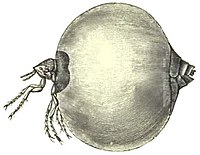
Photo from wikipedia
The human flea, Pulex irritans, is the most important ectoparasite of humans. Intensive use of pyrethroids for its control has led to insecticide resistance. Monitoring pyrethroid resistance and its underlying… Click to show full abstract
The human flea, Pulex irritans, is the most important ectoparasite of humans. Intensive use of pyrethroids for its control has led to insecticide resistance. Monitoring pyrethroid resistance and its underlying mechanisms is essential for flea control. The aims of this study were to identify the susceptibility status of human flea to permethrin and to detect the presence of knockdown resistance (kdr) mutation and its frequency in populations of P. irritans. Adults of P. irritans were collected from Zanjan Province, northwest of Iran, during 2013-2017. Different populations of this flea were exposed to permethrin 0.75% for one and 8 h and then the mortality rate, as well as KD50 and KD95 times were calculated. Total RNA and gDNA of samples were extracted, and the fragments of cDNA encoding the partial voltage-gated sodium channel (VGSC) peptides were amplified using degenerated primers. Specific PCR and TaqMan real-time assays were conducted to characterize the vgsc gene and to detect the presence of mutation and genotyping of the populations. Mortality rates were in the range from 32% to 67% for one-hour and 73% to 90% for eight-hour exposure to permethrin 0.75%. KD50 and KD95 times varied in a range from 46 to 241 and 177 to 899 min, respectively. Sequencing of 70 amplified fragments of gDNA resulted in a 578-bp product. These fragments contained two introns (92 and 63 bp) and three exons (141, 189, and 92 bp) encoding 138 amino acids that encompassed IIS4-IIS6 and the partial linker between domains II and III of VGSC. All the studied populations showed L1014F mutation, substitution of CTT for TTT at the 1014 allele. The result of TaqMan assay for 624 samples showed 96.6% homogenous and 3.36% heterozygous mutant. The development of permethrin resistance and the presence of the L1014F mutation at high frequency in flea populations indicate that pyrethroids are likely ineffective in controlling human flea. Therefore, novel alternative control methods are needed to combat this human ectoparasite.
Journal Title: Pesticide biochemistry and physiology
Year Published: 2018
Link to full text (if available)
Share on Social Media: Sign Up to like & get
recommendations!